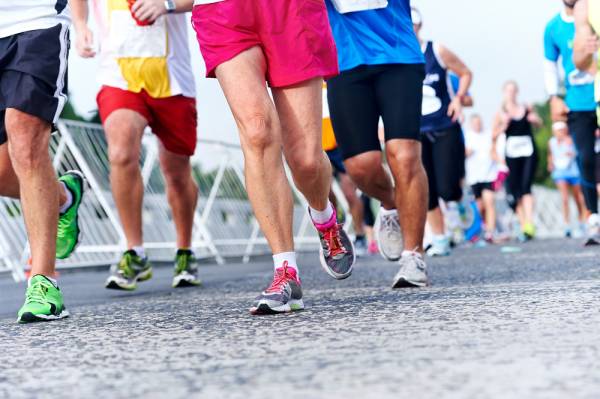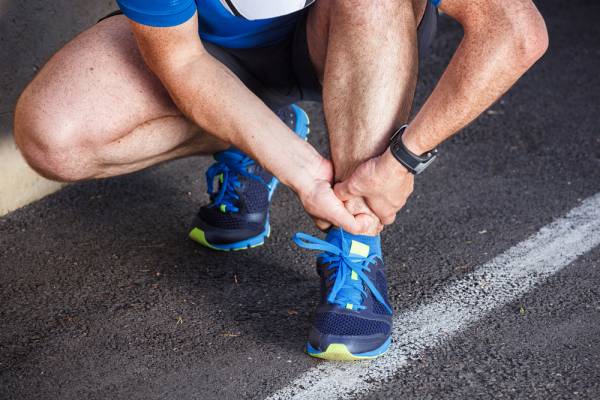Strong ankles are all about supportive shoes and isolated strength exercises, right? No, actually they have nothing to do with either. Those philosophies can even increase your chance of an injury as they don’t allow your foot and ankle to move naturally as they’re intended to.
Proper ankle mobility and stability will decrease your risk of injury and dictate, if you do fall, whether you get back up hobbling or not.
The Ankle Support System
Your ankle is supported with the help of sturdy ligaments whose job is to also provide mechanical feedback to the rest of your body so you can move smoothly and efficiently. These ligaments are a huge part of proprioception, which along with your eyes and inner ears let your brain know where you are in relation to your environment.
“When ankles become fatigued, they fail to provide the necessary feedback so our movements become slow, clumsy, and dampened.”
These ligaments help support muscles and tendons that store elastic energy for propulsion. They’re not meant for power. When ankles become fatigued, they fail to provide the necessary feedback so our movements become slow, clumsy, and dampened. A common sign of this is when one ankle easily rolls inward while landing during the gait cycle – maybe not to the point of injury (a sprain) but enough for you to take notice.
You may blame this occurrence on an uneven surface or some rocks you had to scurry across during a trail run, but the true cause comes down to the fact that your body is fatiguing. This is due to several reasons I will discuss, as your ankles are one of the first places to let you know your body is breaking down.
Stress + Excess Stimuli That Alter Proprioception = Injuries
Proprioception and kinesthesia are terms commonly used to describe position and movement:
- Proprioception is a sense of where your body is as determined by the conscious feedback it receives from muscular, tendon, and articular sources and the unconscious feedback from the cerebellum of your brain.
- Kinesthesia is a sense of that movement, also highly dependent on the information received from your tissues back to your nervous system.
The articular sources (joints) are supported by the ligaments that connect them. The amount of external stress your ligaments can handle will be influenced by the other aspects that affect position and movement. That means if there are tendon and muscular problems, which are common in athletes, there will be more stress to the joints and ligaments. It also means that other types of stress, both internal (e.g. poor lifestyle or diet) and external (e.g. past injuries and improper footwear), can affect proprioception and kinesthesia, and can therefore cause ligament problems.
“The amount of external stress your ligaments can handle will be influenced by the other aspects that affect position and movement.”
In addition to proprioception, body position and movement are also determined by your eyes and inner ear (vestibular system). Excessive stress to your nervous system can alter your body orientation and movement patterns. This can occur from too much training or racing, poor recovery, sleep, or diet. Eventually your eyes can lose fine focus throwing your balance off, and for those who race long hours in any event you know exactly how important this is.

This is why if you close your eyes, it’s much harder to keep your balance, especially if your musculoskeletal feedback system is fatigued (or simply not trained). Stand on one foot with your eyes open and then close your eyes and see how you do. Your balance should be equally as good, yet most people cannot balance and many fall over when they do this.
Muscle imbalances can occur in the head and neck region affecting the inner ear and thus altering body position and movement, too. Now more stress is placed on other tissues of the body, especially ligaments, as muscles and tendons fatigue. These tissues must work extra hard to control movement and posture. Next thing you know, you’re starting to trip on just slightly uneven surfaces and roll an ankle again and again. This is a perfect and rather common example of how a problem in one area of the body (head/neck) can affect a distant area (ankle/foot).
“Additionally, when running and jumping, energy is constantly stored and released in the connective tissues of the foot and especially the ankle. The weaker these tissues are, the less power and speed you will generate.”
Additionally, when running and jumping, energy is constantly stored and released in the connective tissues of the foot and especially the ankle. The weaker these tissues are, the less power and speed you will generate. Conventional footwear often alters proprioception significantly. This can not only result in weakened structural tissues, but also in poor balance and movement.
Orthotics can promote problems, too. If your body isn’t exactly sure how your foot is moving and how it is loading, unloading, and recovering with each and every step, you’re at a high risk for injury. Add in the chronic nervous system and hormonal stress most people are dealing with every day and you’re just waiting to injure your knee or roll an ankle.

Care for Your Ligaments
Ligaments do need some rehabilitation. Walking, standing, moving, and running (if you enjoy it) barefoot or in a shoe that does not alter biomechanics and proprioception are the simplest and most effective ways to aid in ligament repair and recovery, as well as increase overall strength.
“Trigger point work on ligaments is sometimes necessary, but you should be careful if you’re inexperienced and are performing this type of therapy on yourself as you can cause more damage.”
Balancing on one foot or walking across a flat board as we teach in MovNat is ideal for the further development of balance and connective tissue health. Of course, you should never stretch ligament injuries, as ligaments cannot retain their original shape and tension when stretched too much or too often past a certain point. Dynamic movements are good, but prolonged static stretches are not.
Trigger point work on ligaments is sometimes necessary, but you should be careful if you’re inexperienced and are performing this type of therapy on yourself as you can cause more damage. I often advise staying off the actual area where the injury is felt, and instead treat the surrounding “more meaty” muscles, and sometimes tendons. This helps get those tissues working again so the ligaments don’t need to do work they’re not meant to do. That means treating the calves and surrounding lower leg muscles rather than the actual ankle ligaments.
Move Your Whole Body
Focus on your whole body when you move, and even when you need to rehabilitate an area. We don’t move as isolated units. We are dynamic, versatile, vital human beings meant to adapt to a variety of surfaces and conditions. Train your body to do so by challenging it often in a natural environment and it’ll be ready for anything that comes your way.
You’ll Also Enjoy:
- Fix Your Weak Foundation: Your Ankles
- 2 Drills to Injury Proof Your Ankles
- Effects of Ankle Taping on Performance and Safety
- What’s New on Breaking Muscle Today
Photos courtesy of Shutterstock.






